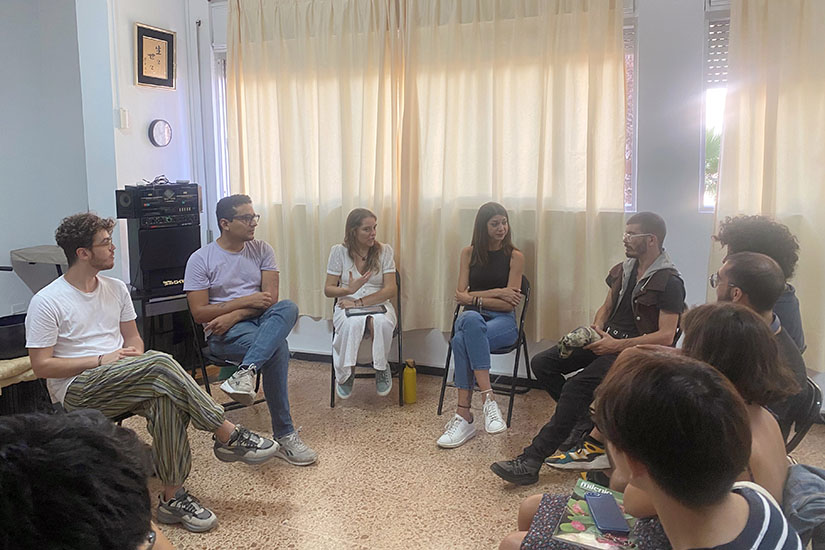Resources for the introduction of SGI-Spain’s discussion meetings
Now when Nichiren and his followers chant Nam-myoho-renge-kyo, they realise the originally inherent nature of birth and death, and the originally inherent nature of ebb and flow.
↳ OTT, page 127. The Record of the Orally Transmitted Teachings are a collection of Nichiren Daishonin’s oral teachings about the Lotus Sutra expounded during his years at Mount Minobu, where he established himself in May 1274 until the 8 of September 1282, just a few weeks before he passed away. These teachings were registered and collected in two volumes by his disciple and successor Nikko Shonin.
The Mystic Law is the fundamental principle extending through both life and death. It underlies not only to human life but all phenomena of the universe. All the living beings of the Ten Worlds and their environments are entities of the Mystic Law. (…)
Because life and death are originally inherent, we have no reason to fear death and can savour joy in both life and death, and be equally happy and at ease with both.
Of course, as mortal human beings, the idea of death can make us feel sad and forlorn. When a loved one dies, waves of grief assail us. But if we steadily continue chanting Nam-myoho-renge-kyo, we can transcend the bounds of life and death and converse with our loved ones. Fellow members will also chant for us and support us in our loss. In time, we will come to find the profound meaning of our loved one’s death and feel a sense of hope for renewal. When we illuminate the sufferings of birth, aging, sickness, and death with the light of the Mystic Law, we can transform them into the joy of eternity, happiness, true self, and purity.
In a letter to the lay nun Myoichi, the Daishonin offers unwavering assurance that her late husband is protecting her and her family (see WND-1, 536). He teaches that when those who have dedicated their lives to the Mystic Law die, their surviving loved ones are sure to be protected and make their way to happiness without fail.[1] (…)
In lifetime after lifetime, we will enjoy benefit and fortune as we continue our work for kosen-rufu and establishing the correct teaching for the peace of the land. Those who undertake that challenge will attain a supreme and unparalleled state of life in perfect rhythm with the Mystic Law, the fundamental Law of the universe.[2]
Through persistently chanting daimoku and deeply studying The Lotus Sutra, Josei Toda, second president of Soka Gakkai, experienced an initial awakening in the prison cell where he had been incarcerated as prisoner of conscience during World War II. This awakening was that the Buddha is… life itself! [3] […] Reflecting upon this, his disciple, Daisaku Ikeda, mentioned that “we can regard all of the Buddhist scriptures as presenting a philosophy of life.”[4]
Having said this, if life consists of birth and death as phases originally inherent to an eternal cycle, to precisely cultivate that life philosophy requires to observe both of the phases. In the XIII century, Nichiren Daishonin commented that “Therefore I should first of all learn about death, and then about other things.” [5] Furthermore, Ikeda Sensei identified as “a central and fundamental challenge for the coming century (the XXI century)” the establishment of a culture “based on an understanding of life and death and of life’s essential eternity.”[6]
In the context of modern civilisation, that avoids facing death, this approach is more than revolutionary. But, the practice of Nichiren Buddhism in Soka Gakkai is revolutionary as it is “a religion of human revolution.”[7]

This meeting took place in September in SGI-Spain’s Cultural Centre in Las Palmas de Gran Canaria. The Canary Islands play a major role in Spain’s kosen-rufu history and the capital city of Gran Canaria will always remain as a model of its push by the youth.[8] This is the reason why pictures such as this one fill hearts with joy, especially those of the pioneers of this undertaking.
Mailbox: prensa@ediciones-civilizacionglobal.com
[1] ↑ Please see Winter Always Turns to Spring, in WND-1, page 535.
[2] ↑ Extracted from the “Estudio” (3/3) section of this issue.
[3] ↑ As mentioned in this section of the previous issue of the magazine, the second awakening of Josei Toda in prison was related to his identity as a Bodhisattva of the Earth.
[4] ↑ The Wisdom of the Lotus Sutra – A Discussion on Religion in the Twenty-first Century, published in the March 1995 Daibyakurenge, the Soka Gakkai’s monthly study journal.
[5] ↑ The importance of the moment of death, in WND-2, page 759.
[6] ↑ IKEDA, Daisaku: “Mahayana Buddhism and Twenty-first Century Civilization”.
[7] ↑ The expression is the title of an important series of dissertations by Daisaku Ikeda.
[8] ↑ In 1992 SGI-Spain’s first national youth general meeting took place in Las Palmas following the “Soka Renaissance” of Spain.

